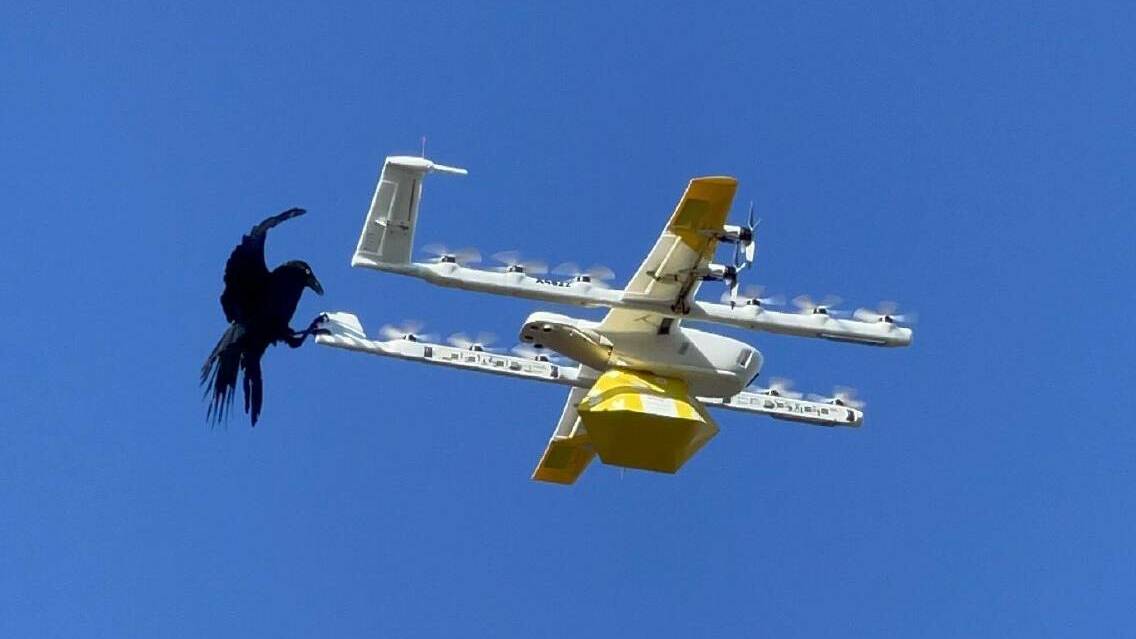It's not quite a remake of the classic horror film The Birds - but it's not far from it.
Subscribe now for unlimited access.
or signup to continue reading
Ravens are learning how to attack the delivery drones which are criss-crossing the skies of Canberra. One pair is getting better at it by the day, according to a witness.
"It's a matter of time before they bring one down," Ben Roberts said.
The angry bird attack has forced the drone company to suspend flights over the area.
Mr Roberts orders coffee each morning and goes out to wait for the buzz of the delivery drone bringing the buzz of the caffeine.
On the first day of aerial combat, they made a hash of the attack - feathers were flying - but by the third day, the two ravens had learned how to avoid the drone blades. Mr Roberts said there were flecks of what he thinks were paint in the air, indicating that the birds had made a hit.
He wonders if they follow it, first hearing the drone of the drone in the distance and then scrambling for the dog fight (as it were).
Mr Roberts has consulted his copy of Birds of Canberra Gardens (Second edition) and is sure that the aggressors are Australian ravens (Corvus coronoides).
It's hard to know what birds make of a drone. It must appear truly weird and presumably threatening to their territory.
"They think it's Terminator or something," Mr Roberts reckons.
He has been ordering coffee drone deliveries to his home in Harrison since the lockdown and is relieved that the birds have not actually prevented delivery. They do not seem to be coffee addicts.
They are more likely to be simply attacking an intruder during the spring nesting season.
Magpies as well as other birds like hawks and wedge-tailed eagles have also been known to attack drones.
Drone operators should try to avoid nesting locations, according to Wayne Condon, the chief pilot and instructor with UAV Training Australia (UAV stands for Unmanned Aerial Vehicle).
He also recommends that a drone operator immediately back the drone away from an attacking bird.
"Bug out. You'll want to get that aircraft out of the same sky as an aggressive bird," he says.
"At the end of the day, it's their sky and we are the visitor. Fingers crossed if you act fast enough, you'll be able to save your aircraft and not injure the bird!"

But Canberra's drones are on auto-pilot and out of sight of the operator.
He also recommends flying early in the morning as the best time to avoid being attacked by birds of prey other than ravens. Raptors like warm thermals to take them high above drones. They like to attack drones from above.
The Canberra ravens seem to go in from the side.
The drone expert also recommends making the aircraft brighter so the operator can spot it on a landscape (though this doesn't seem to apply with Canberra's drones which are already bright and don't always fly in wide, open air).
He says that climbing away from the birds may be difficult in Canberra because of height restrictions on flying so the drone doesn't hit a passenger aircraft.
Canberra's drone company is Wing which is part of the Alphabet company which owns Google.
"We have identified some ravens demonstrating territorial behaviour in a small part of our delivery area in the suburb of Harrison, and we've asked local ornithological experts to investigate this further to ensure we continue to have minimal impact on birdlife," a spokeswoman said.
"Service will be temporarily paused for a small number of our customers in Harrison during this time."
As is common during nesting season, certain bird species demonstrate territorial behaviour and swoop at moving objects.
"However, in the tens of thousands of deliveries we've made to homes in Australia this year, instances of direct contact with birds have been extremely rare."
She said that "in the unlikely event that a bird makes direct contact with our drone", there were fail-safe systems "to ensure we can continue to fly safely".
"We have, and continue to take advice from independent environmental consultants and ornithological experts, to ensure any potential impact to birdlife is minimal."
Our coverage of the health and safety aspects of this outbreak of COVID-19 in the ACT and the lockdown is free for anyone to access. However, we depend on subscription revenue to support our journalism. If you are able, please subscribe here. If you are already a subscriber, thank you for your support. You can also sign up for our newsletters for regular updates.
Our journalists work hard to provide local, up-to-date news to the community. This is how you can continue to access our trusted content:
- Bookmark canberratimes.com.au
- Download our app
- Make sure you are signed up for our breaking and regular headlines newsletters
- Follow us on Twitter
- Follow us on Instagram


